Study: Determine Najee Harris’ contract value through analysis
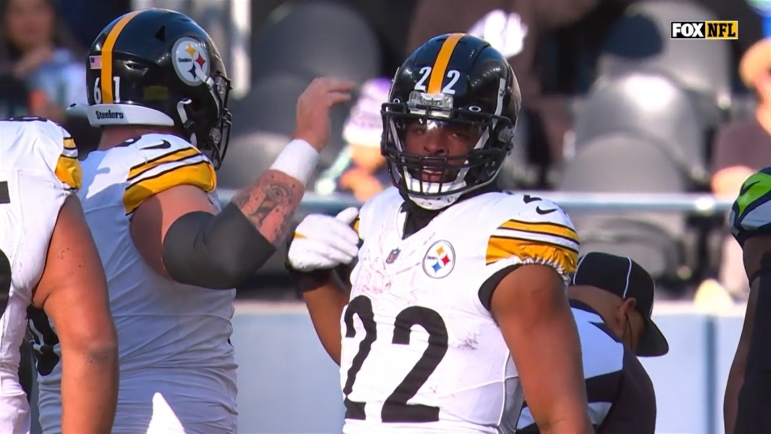
One candidate for a summer contract extension with the Pittsburgh Steelers is running back Najee Harris. My goal today is to take a statistical approach to see how Harris has performed over the last three seasons compared to the current highest-paid players at the position via Over The Cap.
First, I wanted to see where Harris ranks in yards per attempt and yards after contact per attempt on rushes compared to running backs averaging six million or more annually. Many factors can go into yards per attempt, particularly the play of the offensive line, while yards after contact tend to reflect factors that are more in the hands of the running backs.
I averaged these numbers from the last three seasons of Pro Football Focus (PFF) and used the total number of snaps over that time period as the point size. Here are the results:
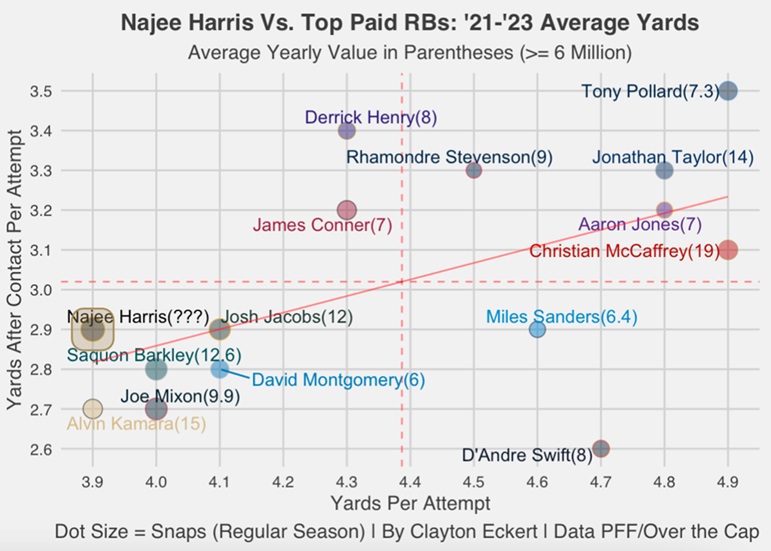

What’s most encouraging for Harris is the total number of snaps represented by the point sizes. He had 2,309 total snaps, which is the most of any of the 15 qualified RBs during that time period. That’s extremely valuable at any position, especially given the attrition RBs face and because it’s an underrated piece of a devalued position group across the NFL.
Looking at the average annual values overall, there are only five RBs over ten million: Christian McCaffrey (19), Alvin Kamara (15), Jonathan Taylor (14), Saquon Barkley (12.6) and Josh Jacobs (12). Only two of them landed in the top right – McCaffrey and Taylor.
Three of those five players have moved teams in the last three years, along with ten of the 15 focused players, further highlighting how willing teams have been to move on from quality RBs and the fungible market as a whole, despite the importance of the position.
Coming back to Harris, we see that he was below average in both yardage data points. The large number of plays compared to his peers is an important factor, but it also gives a relative measure of quality. His 3.9 yards per attempt is the lowest among qualifiers, while his 2.9 yards after contact ranks him eighth with Josh Jacobs and Miles Sanders.
As I said at the beginning, yards after contact is the more important number for RBs, and Harris’ better performance in that regard helps his cause, especially given the subpar offensive line units Pittsburgh has fielded over the past three seasons.
On the other hand, he was still below average among his peers. Several notable players performed above average, including some at the top of the market (McCaffrey, Taylor), newly signed Patriots RB Rhamondre Stevenson and former Steeler James Conner.
Our own cap guru Dave Bryan compared Stevenson’s new contract to his proposed Harris extension, which you should definitely check out. In that post, Bryan suggested an average new money amount of $9.9 million, which would dwarf Stevenson ($9.0 million). The latter fared much better in the yardage graph above, but that came with the fewest snaps of the time frame, 1,445, compared to Harris as the leader with 2,309.
Now we have some early insights into the current contracts for this position and where Harris’ second contract might fit so far.
To dig even deeper, here is a ranking of the stats from the first figure, including yards per attempt (YPARK), yards after contact per attempt (YACRK), averaging the two (AVGRK), then using total snaps as the decision criteria to get a final ranking (TOTRK) of the 15 qualified players along with their average annual values (AYV) in parentheses:
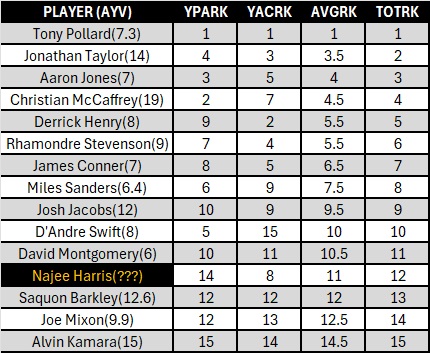

Harris comes in at No. 12 of the 15 qualifiers, which isn’t great considering the likelihood of a potential contract extension. Pittsburgh also recently declined to pick up his fifth-year option, which is worth around $6.7 million compared to his current average annual value of $3.3 million on his current rookie contract.
Considering all factors, he may be the least likely candidate for a contract extension. Defensive linemen Cameron Heyward and tight end Pat Freiermuth are considered more likely.
Next, I wanted to look at multiple facets of the game over the three-year span, another underrated element of the RB game. The following chart shows PFF grades for rushing, receiving, and pass blocking:
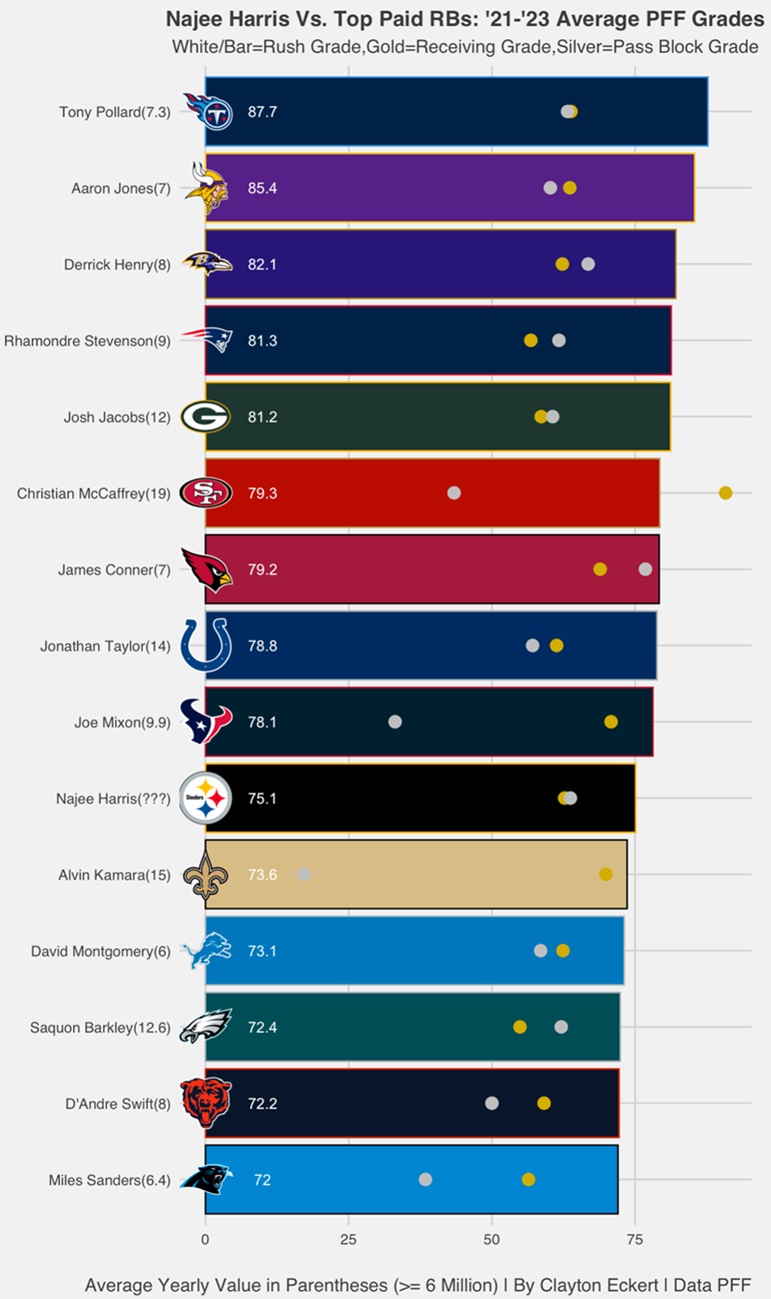

There’s a ton of information to decipher here. First, the bars display and rank the best to worst rushing grades across sample size, with Harris coming in at 10th at 75.1. Considering PFF’s grades are on a play-by-play basis and many things go into the equation, it’s notable that he climbed up the rankings compared to the original view.
The dots represent the other ratings, with the gold dot showing the pass blocking ratings and the silver dot showing the pass blocking ratings. Harris had a 62.7 pass blocking rating and a 63.7 pass blocking rating over time, which doesn’t sound impressive but ranks seventh and third, respectively. So Harris has done more than just rushing as a versatile running back, despite losing opportunities to the rise of fellow Pittsburgh player Jaylen Warren over the past two seasons.
The latter is another reason why many are against a potential contract extension with Harris. I feel the two complement each other very well and it would be worth keeping them together for the right price to see if the running game becomes more consistent with the investment in the offensive line and that side of the ball this offseason.
Now here is a similar ranking as before, including rushing grade (RUSHRK), receiver grade (RECRK), pass blocking grade (PBKRK), average of three (AVRRK), and then using the same tiebreaker for total snaps to determine the final rank (TOTRK):
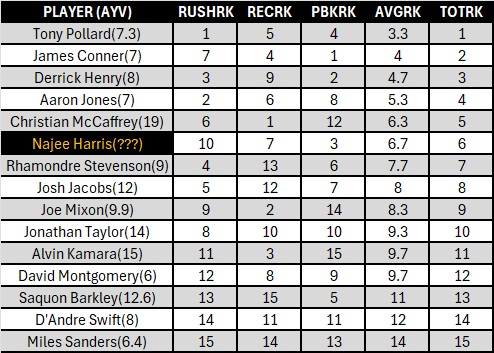

That view paints Harris in a much more favorable light, as he ranks sixth overall among his 15 qualified peers. Yes, Harris played less on passing attempts where he performed best, namely third downs, as Warren took more of those opportunities with good play. But that’s no disparagement to Harris, who also contributed in the passing game.
The main reason for this is that Warren has the greater ability to play more explosively, although Harris has made progress in that regard after struggling with explosive plays in college and his first two years in the league.
It’s rare to find a running back that can do everything at an average or better level, and I feel Harris falls into that camp. Guys like Tony Pollard, Conner, Derrick Henry, Aaron Jones, Taylor and Harris rank in the top ten in every class, with an average annual value of seven to 14 million.
Harris would likely balk at the lower end of that price range, but shouldn’t expect to finish at the higher end either. He ends up finishing just above Stevenson at the final table, which seems reasonable given Bryan’s opinions, which I outlined earlier.
Interestingly, there is a notable gap between players under ten million and the next highest player, Jacobs at $12 million, which certainly impacts a potential Harris deal.
Should Pittsburgh decide to offer Harris a contract extension, an average annual value in the range of nine million, as outlined by Bryan, also seems reasonable from a strictly analytical point of view.



